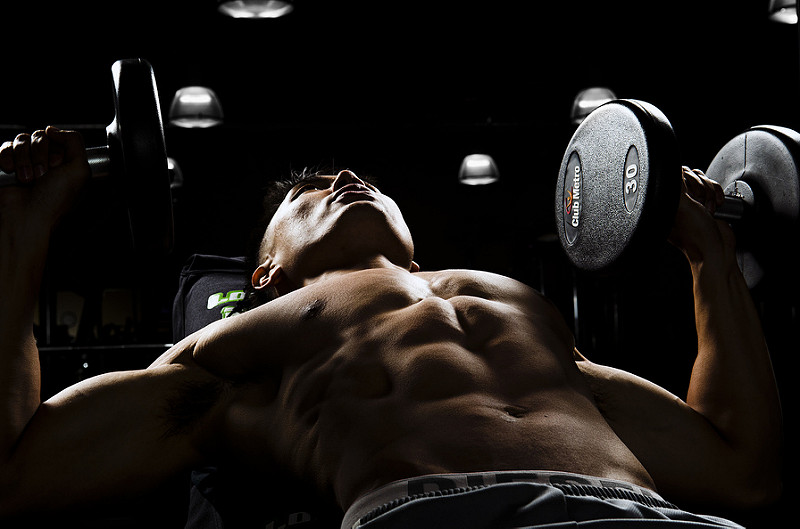
Here is a simple concept you can use to dramatically improve your fitness results starting today.
Barbell Bench Press < Dumbbell Bench Press & Barbell Bench Press together (i.e. in the same workout and/or program)
In other words, you’ll get better results from bench pressing with both barbells and dumbbells than you will from just using barbells alone.
Here’s another example.
Barbell Bench Press (BBP) on a flat bench < BBP on flat bench, incline bench, and decline bench
In other words, you’ll get better results from bench pressing at different angles than you will from specializing in just one.
How about another example?
Barbell bench press < BBP with standard grip, wide grip, and close grip
In other words, you’ll get better results from varying your grip width on the bench press exercise than you will from only ever using the same grip.
Okay. Want to really throw your head for a loop?
Barbell bench press < BBP at different angles AND with different grips (e.g. close grip decline BBP, standard grip BBP on flat bench, wide grip incline BBP)
In other words, you’ll get better results from varying both the grips and angles that you train the bench press exercise.
Then you can try those variations with dumbbells instead of barbells. Or, kettlebells if you have them.
You can also alter your rep speed (i.e. tempo). Do some reps very slow, some very fast, and some in between. Do some strict reps. Maybe even some cheat reps. Train full range of motion, and partial reps, too. Then train the same horizontal pressing pattern with a different exercise like pushups, and apply the same methods above, which opens up a myriad of additional options.
Then apply the concept to the other exercises you do (e.g. squat, hinge, loaded carries, Shake weight, etc.).
Do you see where I’m getting at?
You’ll get more balanced and well-rounded strength, muscle, and fitness development by training a broad range of fitness activities instead of just specializing in one or two.
The trick is finding the proper balance between all of these factors and strategies. Or, at least, the ones that matter most for your particular fitness goals because you certainly don’t have to do all of these.
And of course, you still have to account for the laws of conditioning, such as the law of specificity, the law of adaptation, and the law of progressive overload, among others. You still need to stick with the basics. And obviously, you’ll have a really hard time getting anywhere if you just train randomly, which is like playing the lottery with your results (i.e. the odds are against you).
But if you find the sweet spot between specificity and variety, your results will soar. And your chances of staying injury-free for the long haul increase dramatically, too. Plus, you’ll no longer be a “one trick fitness pony.” You’ll be a “I can handle pretty much anything fitness pony.” And everyone wants to be an “I can handle pretty much anything fitness pony.”
Now, if you don’t have a coach who can balance all of these strategies over the long term for you, here’s a hint for getting started. Don’t try to do it all at once. Incorporate one or maybe two changes to your normal routine and see how it goes. Remember, baby steps.
Oh, and by the way, this concept isn’t limited to strength activities. It can be applied to almost any fitness-enhancing activity.
Take running, for example. You can run slow for long distance or sprint for short distances. You can do pace work and interval training. You can run uphill, downhill, on roads, trails, or the track. You can run warm or cold. You can just run, or you can incorporate other natural movement training into your runs. (e.g. jumping, balancing, crawling, etc.), among other ways of diversifying your running.
The Bottom Line: The more your diversify your running, the more well-rounded of a runner you’ll be.
And it’s not limited to running either, but can be applied to any human movement skill, like something as simple as jumping. So, don’t merely fixate on the 24″ box jump – mindlessly doing dozens or hundreds of reps, to the exclusion of all else. Get better at jumping in all kinds of different ways – for distance, for height, from two legs or one, from standing or from a walk or run, to a precision landing, while holding something, etc.
Similarly, instead of doing just 100 kettlebell swings straight, do 20 swings, 20 cleans, 20 snatches, 20 jerks, and 20 long cycle clean and jerks. Do heavy kettlebell work and light kettlebell work. Learn hard style and soft style. Then find your own style. And instead of just doing barbell back squats, do front squats, overhead squats, and zercher squats. Squat with barbells, dumbbells, sandbags, kettlebells, clubbells, bands, chains. Do super slow squats, jump squats, and isometric squats. Do light squats for high reps and heavy squats for low reps.
Pro Tip: don’t do it all in the same day.
See what I mean?
If you apply this idea to your weightlifting, kettlebell training, or whatever it is that you do, you’ll begin to reap new benefits that you just can’t get from over-specialized training.
Food for thought action: what can you do today or next time you train to broaden the spectrum of your training?
If you found this article helpful, please share it with your friends:
.jpg)
![]()
Health-First Fitness Coach
P.S. If you liked this post, then please signup for the newsletter, or follow me on Facebook or Twitter for daily updates and other interesting info.
Photo credit: 1.

very inspiring and useful information.